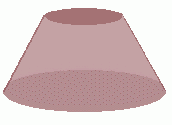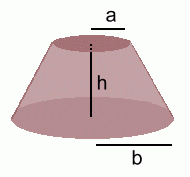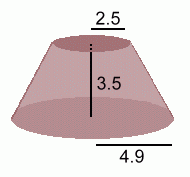

A very common calculation, one that I have been asked to provide often to local farmers, involves finding the volume of a pile of grain that has roughly the shape shown above. The difficulty with this calculation is that the shape is not one for which there is a commonly known formula. It is not, for example, mentioned in high school mathematics courses. The name of this shape is a frustum, and it is the bottom of a cone.
|
In order to calculate the volume of this shape, you will need three measurements:
- the height of the object, labelled h
- the radius of the top, labelled a (this is half the width at the top)
- the radius of the bottom, labelled b (this is half the width at the bottom)
|

|
The formula for the volume of this shape also requires that you know the value for PI:

Here's the formula you will need, to calculate the volume of a pile of grain in the shape of a frustum:

It looks complicated, but it's easy to use if you have a calculator (one with brackets) and have estimates of the three measurements described above. Here's an example of the formula in use:
|
In this example, the pile of grain is 3.5 metres high, and the half-widths at top and bottom are 2.5 and 4.9 metres, as shown at the right.
In order to get an accurate answer, the pile needs to be circular. It should resemble a frustum fairly closely; the larger the pile, the less critical the shape is. (In other words, for a large pile, you don't need to worry too much if the top isn't exactly flat). However, you do need estimates of the measurements that are as accurate as you can manage.
|

|
Here's the calculation:


You can multiply the answer in cubic metres by 35.3147 to get about 5500 cubic feet.
For your convenience, we've included the relevant information from this page in a PDF document which you can download here and print, to use at your convenience.
|
Resources
|



